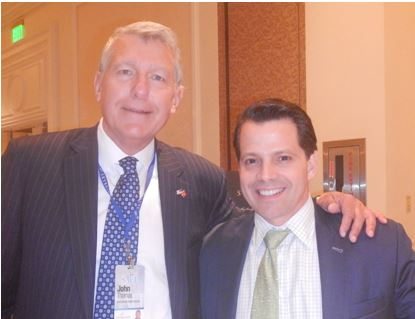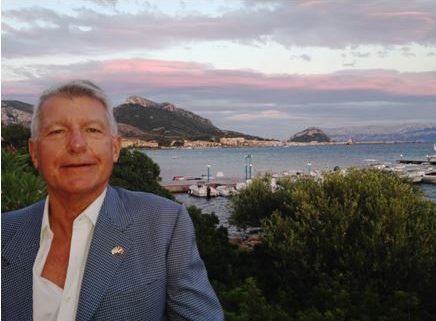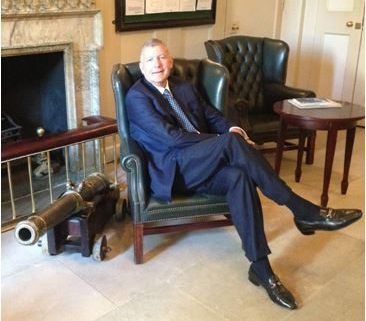Global Market Comments
July 21, 2014
Fiat Lux
Featured Trade:
(CHECKING IN WITH SKYBRIDGE?S ANTHONY SCARAMUCCI)
?We are in a broad based liquidity driven bull market.? Furthermore, the major indexes are poised to tack on ?another 10% by the end of this year.?
That was the informed view of SkyBridge Capital managing partner Anthony Scaramucci, known as the ?Mooch? to his friends. I touched based with Anthony while passing through New York a few weeks ago.
Scaramucci?s Views are not to be taken lightly. SkyBridge Capital is a research driven alternative investment firm with over $10 billion in?total assets under advisement or management. The firm offers?hedge fund investing solutions?that address?a wide range of market participants from individual retail investors to large institutions.
SkyBridge tracks the strategies, outlooks, and the performance of many of the 10,000 hedge funds managing $2.7 trillion in assets. As a result, there are few better reads out there on where the global financial markets are heading than the view at SkyBridge.
Anthony says there are three major drivers for the markets today. A race to the bottom by central banks globally is forcing unprecedented liquidity into the markets.
Zero interest rates and a $4.6 trillion balance sheet have effectively made the Federal Reserve the world?s largest hedge fund. There are no longer any bond vigilantes to bring discipline.
Less appreciated by traders is the fine print in the Dodd/Frank financial regulation bill that has unleashed a new generation of corporate raiders. Corporations are using the $2 trillion in cash on their balance sheets to fight back, repurchasing their own shares. Thus, company buy backs are at all time highs, and there is much more to come.
All of this means that financial assets of every description can only go one direction, and that is northward.
One result of this is that index funds are beating the pants off of hedge funds. Long/short equity managers, which comprise 43% of the funds out there, are underperforming for the sixth consecutive year.
Macro funds are getting destroyed because many historical cross asset relationships have broken down. Suddenly, the world no longer makes sense to them and has apparently gone mad, at the investors? expense.
To me, this is all a classic sign of too much hedge fund money chasing too few trades. The hedge fund industry has gotten too big for its britches.
I learned in Japan?s never end bear market that when you only have hedge funds trading with hedge funds, nobody makes any money.
Another issue is our antiquated tax code, which has remained frozen in the 1980?s. Any attempt to change it is thwarted by well-funded special interests, at the economy?s, and your expense.
To broaden its horizons and enhance insights for its clients, SkyBridge recently purchased the rights to the old ?Wall Street Week? from Maryland Public Broadcasting, the once venerable TV investment program hosted by the respected Louis Rukeyser.
Scaramucci believes that the financial media have been hijacked by the 24-hour news cycle that distills crucial information down to 30-second bullet points. Complex economic and investment issues deserve a more thoughtful and extended analysis. Anthony plans to restart the long format program sometime next year.
Scaramucci is the author of two books, The Little Book of Hedge Funds: What You Need to Know About Hedge Funds but the Managers Won?t Tell You, and Goodbye Gordon Gekko: How to Find Your Fortune Without Losing Your Soul.
On my way out of Anthony?s office I noticed a K-bar, a vintage WWII combat utility knife, mounted in a plaque on the wall with a message of thanks from Wounded Warriors Project (click here for their site http://www.woundedwarriorproject.org ).
I laughed, as I have the exact same plaque on my wall at home. The blade is still razor sharp. In recent years, Anthony has raised an impressive $5 million for the worthy veterans organization.
I thanked the ?Mooch? for his contribution and headed out the door for the Lexington line, hoping to beat the rush hour traffic.
 Checking in with the ?Mooch?
Checking in with the ?Mooch?
Global Market Comments
July 18, 2014
Fiat Lux
Featured Trade:
(MAD HEDGE FUND TRADER SETS NEW ALL TIME HIGH WITH 22.9% GAIN IN 2014),
(AAPL), (CAT), (MSFT), (TLT), (GM), (SPY)
(PLAY CHINA?S YUAN FROM THE LONG SIDE),
(CYB), ($SSEC), (EEM)
Apple Inc. (AAPL)
Caterpillar Inc. (CAT)
Microsoft Corporation (MSFT)
iShares 20+ Year Treasury Bond (TLT)
General Motors Company (GM)
SPDR S&P 500 (SPY)
WisdomTree Chinese Yuan Strategy ETF (CYB)
Shanghai Stock Exchange Compostite Index ($SSEC)
iShares MSCI Emerging Markets (EEM)
I am writing this to you from the island of Sardinia, part of Italy, a clump of arid mountains dropped right in the middle of the western Mediterranean.
I am bobbing offshore from Porto Cuervo on the famed Costa Smeralda, or Emerald Coast, in a friend?s 100-foot sailboat, awaiting permission to enter.
The water here is so clear that the boats appear to float on air. This afternoon I swam at La Spiaggia Rosa on Budelli Island, famed as the most perfect beach in Italy.
After making a fortune for his hedge fund clients following my Trade Alerts over the past year, a week?s free use of my friend?s favorite toy was the least he could do. Renting this baby costs $50,000 a week, not including tips for the crew, which I covered.
The harbor is so clogged with the traffic of mega yachts belonging to Russian oligarchs, Arab sheiks and other hedge fund managers, that there is no room for us to dock. The ship belonging to the Crown Prince of Saudi Arabia floats just ahead of us in the queue, a nice little 150 footer. So that?s where all my gas money goes! (Or went, now that I am a Tesla driver).
Despite these distractions, I am happy to report that the industry beating performance of the Mad Hedge Fund Trader?s Trade Alert Service has punched through to a new all time high.
The total return for my followers so far in 2014 has reached 22.9%, compared to a far more arthritic 3% for the Dow Average during the same period. So far in July, followers have earned a welcome 3.14%.
I managed to pull this off during some of the most difficult trading conditions in market history. Turnover across all asset classes is hitting decade lows (see chart below), and volatility has crashed through the floor.
Even on the big down days, the Volatility Index reached no higher than the 12% handle. Most of the rest of the hedge fund industry is getting walloped.
The three and a half year return is now at an amazing 145.3%, compared to a far more modest increase for the Dow Average during the same period of only 37%.
That brings my averaged annualized return up to 40.6%. Not bad in this zero interest rate world. It appears better to reach for capital gains than the paltry yields out there.
This has been the profit since my groundbreaking trade mentoring service was first launched in 2010. Thousands of followers now earn a full time living solely from my Trade Alerts, a development of which I am immensely proud of.
Another particularly vexing challenge is that the principal market driver has shifted from economics to geopolitics. The global economic recovery continues, but at a snail?s pace, so it hardly moves the needle on the volatility front.
The carnage in Syria, Iraq, and the Ukraine continues unabated, but nobody seems to care, except for a handful of humanitarian organizations. Not even the potential bankruptcy of a Portuguese bank, the Banco Espiritu Santo, could get the markets to correct for more than an hour. But get a new rumor about Apple?s impending launch of its iPhone 6, and it?s off to the races.
I learned a long time ago to trade the market you have, not the one you wish you had. The world seems to be drowning in complacency.
However, I am using every dip to add risk and every rally to take it back off, keeping positions small all along the way. I am also trading front month options only to minimize my own volatility and pare the hit when a correction finally does come.
It has become yeoman?s work.
So, in the relentless grind up, I took profits on my Caterpillar (CAT) position. My long in Microsoft options (MSFT) is set to expire at its maximum value today. My short position in the S&P 500, the July (SPY) $199 puts, will imminently expire worthless. That?s the way you want to play it; your longs tack on 20% and your shorts go to zero.
I also added a hedging short in the Euro (FXE) and an additional long in Apple (AAPL), of course!
In the meantime, the world is waiting to see whether the US can deliver a second half GDP growth rate of 4% per annum?or not.
Quite a few followers were able to move fast enough to cash in on the move. To read the plaudits yourself, please go to my testimonials page by clicking here. They are all real and new ones come in almost every day.
My esteemed colleague, Mad Day Trader Jim Parker, was no slouch either, dodging in an out of the raindrops to make money on an intra day basis.
What would you expect with a combined 85 years of market experience between the two of us? Followers are laughing all the way to the bank.
Don?t forget that Jim clocked an amazing 2013 with a staggering 374% trading profit. That was just for an eight-month year!
The Opening Bell With Jim Parker, a quickie but insightful webinar giving followers an instant snapshot of the market opening every day, has been an overwhelming success. Many customers have already reported dramatic improvements in their trading results.
Watch this space, because the crack team at Mad Hedge Fund Trader has more new products and services cooking in the oven. You?ll hear about them as soon as they are out of beta testing.
Our business is booming, so I am plowing profits back in to enhance our added value for you. Now available is the Mad Hedge Fund Trader Channel on YouTube that will enable me to post videos from my frequent travels around the world.
The coming year promises to deliver a harvest of new trading opportunities. The big driver will be a global synchronized recovery that promises to drive markets into the stratosphere by the end of 2014.
Global Trading Dispatch, my highly innovative and successful trade-mentoring program, earned a net return for readers of 40.17% in 2011, 14.87% in 2012, and 67.45% in 2013.
Our flagship product,?Mad Hedge Fund Trader PRO, costs $4,500 a year. It includes my Global Trading Dispatch?(my trade alert service and daily newsletter). You get a real-time trading portfolio, an enormous research database, and live biweekly strategy webinars. You also get Jim Parker?s?Mad Day Trader?service and?The Opening Bell with Jim Parker.
To subscribe, please go to my website at?www.madhedgefundtrader.com, find the ?Global Trading Dispatch??or ?Mad Hedge Fund Trader PRO??box on the right, and click on the blue??SUBSCRIBE NOW??button.
 The Most Perfect Beach in Italy
The Most Perfect Beach in Italy
 Hello from Sardinia
Hello from Sardinia
Global Market Comments
July 17, 2014
Fiat Lux
Featured Trade:
(JULY 24 ZERMATT, SWITZERLAND GLOBAL STRATEGY SEMINAR)
(ANNOUNCING THE MAD HEDGE FUND TRADER VIDEO CHANNEL ON YOUTUBE),
(THE ULTRA BULL ARGUMENT FOR GOLD),
(GLD), (GDX), (ABX), (SLV)
SPDR Gold Shares (GLD)
Market Vectors Gold Miners ETF (GDX)
Barrick Gold Corporation (ABX)
iShares Silver Trust (SLV)
Come join me for afternoon tea for the Mad Hedge Fund Trader?s Global Strategy Seminar, which I will be conducting high in the Alps in Zermatt, Switzerland at 2:00 PM on Thursday, July 24, 2014.
A PowerPoint presentation will be followed by an open discussion on the crucial issues facing investors today. Coffee, tea, and schnapps will be made available, along with light snacks.
You are welcome to attend in your mountain climbing gear, but you will have to leave your boots at the door. Socks only are welcome, and if it?s cold, we will throw some extra wood on the fire. Last year, someone came down from the Matterhorn summit straight to the seminar, sunburned and tired, but elated. He even gave me a valued pebble from the summit.
I?ll be giving you my up to date view on stocks, bonds, foreign currencies, commodities, precious metals, and real estate. And to keep you in suspense, I?ll be throwing a few surprises out there too. Enough charts, tables, graphs, and statistics will be thrown at you to keep your ears ringing for a week. Tickets are available for $195.
I?ll be arriving early and leaving late in case anyone wants to have a one on one discussion, or just sit around and chew the fat about the financial markets.
The event will be held at a central Zermatt hotel with a great Matterhorn view, operated by one of the village?s oldest families and long time friends of mine. The hotel is just down the street from the town?s beautiful 17th century church.
The details will be emailed directly to you with your confirmation.
I look forward to meeting you, and thank you for supporting my research. To purchase tickets for the luncheons, please go to my online store.
One request I get more than any other, is to expand on my half century of international travel, provide a business, economic, and historical backdrop, and place it in today?s global context.
Shake up such a cocktail of experience and knowledge, and more than a few trading and investment ideas spill over the top. If it?s funny, that helps too.
It seems that I am one of a tiny handful of people still alive in the world today who can do this.
Therefore, I am launching the Mad Hedge Fund Trader Video Channel on YouTube. This will provide the opportunity to offer you informative and well-researched videos on my non-stop travels around the world.
This is not your normal travel show. Think of it as Lifestyles of the Rich and Famous meets The Economist and the History Channel, all couched in a language any trader will understand.
I am not going to tell you about the standard, top ten sights in every city. Any guidebook bought at Amazon or found on line can do a better job than me. Instead, I will take you to the out of the way, the quirky, and the unconventional.
These are places of interest I have accumulated over five decades of living out of backpacks and suitcases. The goal is for you to learn from every single segment.
One of the great advantages of spending so long on the road is that I can chronicle the momentous changes that civilization has endured over the past half century. And sometimes, what hasn?t changed is much more impressive than what has.
I will be the sole producer of content for this show, grinding out entertainment and education as easy and cheaply as possible. Like everything else on the Internet, I am looking to achieve zero cost and infinite distribution.
So, all of the audio will be shot on my iPhone 5s. A running audio commentary will be provided via the Audio Memos app. Since the iPhone 5s is so sensitive, it picks up all the ambient sounds around me. I can only provide live audio when there is dead silence elsewhere.
Since the 19th century broadband found in many foreign hotels makes it difficult for me to email content back to the head office, segments are limited to a minute each. Each program will run from 15-30 minutes in length.
Full disclosure: None of the people involved in the production of this program have the slightest idea of what they are doing. They include the producers, editors, website designers, researchers, and of course, myself, the presenter, writer, and cameraman.
However, as with the inception of the Diary of a Mad Hedge Fund Trader seven years ago, we shall push ourselves down the learning curve at hyper speed, or we shall perish. In a few months, these shows should get pretty good and might even make an appearance on a cable TV channel someday.
If you have any suggestions for how we might improve this service, or comments of any kind, positive or negative, please don?t hesitate to email me at support@madhedgefundtrader.com . Just put ?Video show? in the subject line and it will go straight to me.
You can?t beat the price. It?s free. The philosophy of this business has always been to charge people for the content that makes them money, like our market beating Trade Alert service, and give everything else away for nothing.
In the online business world, this is known as the ?walled garden? strategy whereby the public gets a taste of the far greater delights to be found with an upgrade. I was one of the originators of this revolutionary concept, and it appears that much of the mass media are now copying me.
It is true that imitation is in sincerest for of flattery.
So please come join me on my never-ending adventures. The first one is to London, England, which you watch by clicking here. Or just go to my home page at www.madhedgefundtrader.com and click on the ?MHFT Videos? menu tab.
Bon Voyage!
Global Market Comments
July 16, 2014
Fiat Lux
Featured Trade:
(LAST CHANCE TO ATTEND THE JULY 18 BARCELONA, SPAIN STRATEGY LUNCHEON)
?(AN EVENING WITH TEXAS GOVERNOR RICK PERRY),
?(LNG), (UNG), (TSLA)
Cheniere Energy, Inc. (LNG)
United States Natural Gas (UNG)
Tesla Motors, Inc. (TSLA)
Global Market Comments
July 15, 2014
Fiat Lux
Featured Trade:
(JULY 17 GLOBAL STRATEGY WEBINAR FROM BARCELONA, SPAIN),
(JUMPING BACK INTO APPLE), (AAPL),
(HOW TO AVOID PONZI SCHEMES)
Apple Inc. (AAPL)
Legal Disclaimer
There is a very high degree of risk involved in trading. Past results are not indicative of future returns. MadHedgeFundTrader.com and all individuals affiliated with this site assume no responsibilities for your trading and investment results. The indicators, strategies, columns, articles and all other features are for educational purposes only and should not be construed as investment advice. Information for futures trading observations are obtained from sources believed to be reliable, but we do not warrant its completeness or accuracy, or warrant any results from the use of the information. Your use of the trading observations is entirely at your own risk and it is your sole responsibility to evaluate the accuracy, completeness and usefulness of the information. You must assess the risk of any trade with your broker and make your own independent decisions regarding any securities mentioned herein. Affiliates of MadHedgeFundTrader.com may have a position or effect transactions in the securities described herein (or options thereon) and/or otherwise employ trading strategies that may be consistent or inconsistent with the provided strategies.














